Bursitis elbow joint develops with inflammation of the bursa (or "bursa" in Latin). This section is filled with fluid that softens friction in the elbow joint. With the development of the inflammatory process, the tissues of the elbow joint swell, the amount of synovial fluid increases, and pain in the elbow often becomes unbearable.
Find out the reasons for the development of elbow bursitis, symptoms, methods of diagnosing the disease. Take note folk recipes, complementing traditional methods of treating inflammatory processes in the joint capsule.
The reasons for the development of the disease

Elbow bursitis develops under the influence of negative factors. Sometimes the joint experiences external and internal influences that increase inflammation.
Main reasons:
- abrasions, scratches, microtrauma, through which pathogenic microbes easily penetrate;
- inflammatory processes in various parts of the body. With the flow of lymph and blood, bacteria, viruses quickly colonize synovial fluid, acute bursitis develops;
- systemic pathologies affecting the musculoskeletal system: scleroderma, gout, rheumatoid arthritis;
- active sports, hard work with frequent exposure to the elbow joint.
Characteristic signs and symptoms
After infection of the joint capsule, a pathological process develops, the first signs of bursitis appear. If you do not pay attention to them, start the disease, the inflammation will go from an acute to a purulent stage, later it will take on a chronic, recurrent nature.
Be sure to visit an orthopedic traumatologist if you find the following symptoms:
- soreness when moving the elbow;
- swelling of sizes from 7 to 10 cm. Protrusion of tissues, rather soft to the touch;
- when palpating, the movement of synovial fluid is easily felt;
- bag effusion is a favorable environment for the growth of pathogenic bacteria. When infected, soft tissues melt, a dangerous complication develops - phlegmon of the elbow charter;
- the appearance of pus in the joint capsule is indicated by an increased temperature, redness of the joint area, severe pain at the slightest movement;
- in the absence of therapy, further activation of the inflammatory process, the state of health worsens, the intoxication of the body continues;
- the patient is tormented by bouts of nausea, vomiting. With a high aggressiveness of the pathogen, delusional syndrome, confusion, and increased fatigue were noted.
Types of pathology

By the nature of the pathological changes, four types of elbow bursitis are distinguished:
- spicy;
- purulent;
- chronic;
- recurrent.
Diagnostics
For discomfort in the elbow joint, tissue swelling, painful sensations, visit an orthopedic traumatologist. With severe inflammation, bursitis is easy to distinguish.
In milder cases, additional research is required to make an accurate diagnosis:
- Ultrasound of the problem joint.
- X-ray.
- MRI to detect inflammation in deep bursae.
Patients ask how to distinguish arthritis from bursitis. Many signs are similar, but there is a main difference: with arthritis, it is almost impossible to move the elbow; with bursitis, movements with inflammation of the joint capsules are possible, although very painful.
How to treat at home: effective methods
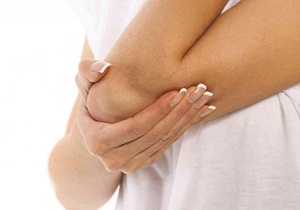
How to treat elbow bursitis at home? The duration of therapy is from three weeks or longer. During treatment, the patient often experiences severe pain: a scar forms in the elbow joint.
At the end of the main course, rehabilitation is required to improve the condition of the tendons, muscles, joints. The doctor will prescribe exercise therapy (physiotherapy exercises), massage. The patient himself performs special exercises (after training with the doctor of the exercise therapy office) at home.
The massage should be performed by a specialist. With the chronic and recurrent nature of the disease, loved ones will have to learn the basic techniques for high-quality rehabilitation of the sufferer after each attack.
Many patients, in addition to anti-inflammatory ointments and gels (Voltaren, Indomethacin, Traumeel C, Dimexide, Diclofenac preparations), use folk recipes for bursitis of the elbow joint. Complex treatment lasts several weeks and requires regular use of home formulations.
Consult with a traumatologist, clarify which remedy is better. If it is not possible to immediately consult a doctor, prescriptions traditional medicine with bursitis, they will reduce inflammation, reduce pain.
Important! With a purulent form, you cannot warm up a sore elbow! Heat activates the inflammatory process, accelerates the spread of pus to new areas.
Effective formulations and methods:
- coniferous baths. Collect the young needles, if any, green cones. Put 4–5 tablespoons of pine needles in a saucepan, put a few cones, pour in a couple of liters of boiling water, close the lid. After 6 hours, the coniferous elixir is ready. Strain the liquid, pour into the bath. The duration of the procedure is a quarter of an hour;
- cabbage leaf compress. This method is effective not only for bursitis, but also for arthritis. Wash the sheet, remove the sinewy part, cut or beat off until juice appears, attach to a sore spot, bandage, insulate with a soft cloth. Cabbage perfectly "draws out" inflammation, relieves pain. Once the leaf is dry and hot (after about half an hour), replace the compress with a fresh one. Keep the cabbage on the elbow longer: the product is harmless;
- bath with hay dust. You will need 3 liters of cold water, 1 kg of hay dust. Boil the mixture, simmer over low heat for half an hour. Remove the pot from the stove, wait 10 minutes, strain, add warm broth to the bath. Time of a useful procedure - 20 minutes;
- compress with a decoction of burdock root. Cut a couple of roots, take 2 tbsp. l. raw materials. Add a liter of boiling water to the container. Keep the burdock broth over low heat for 15 minutes, then set aside, let it brew for 15 minutes. Moisten gauze with healing liquid, apply to the sore elbow, insulate. Change the compress after half an hour and so on 2 more times during the day. The course of treatment is up to three weeks;
- aloe for bursitis."Home doctor", as the medicinal plant is often called, is effective in inflammatory processes in different parts of the body. Cut the washed sheet, select the pulp, put it on cheesecloth, and tie it to the problem elbow. Keep the aloe on the inflamed area for about an hour, change the compress, wait another hour. Course - 2 weeks;
- Kalanchoe against inflammation. Chop large leaves, slightly dilute the gruel with water, apply to the swollen area, cover with gauze or flannel, and bandage. Make sure that the sore spot is not compressed. Keep the compress for 2 hours, repeat the procedure daily;
- a mixture of propolis and butter. Means for internal use. The combination of beneficial ingredients heals the body from the inside out. Combine 20 g of soft quality butter with 30 g of bee product. For a healing effect, take the mixture daily, 1 tsp. 15 minutes before meals. The optimal frequency is three times a day;
- herbal baths. Steam chamomile and calendula (2 tablespoons of ingredients each) in a liter of boiling water. The healing infusion is ready in 40–45 minutes. Pour the strained product into the tub. The duration of the session is 20 minutes. The herbal decoction effectively relieves inflammation. In case of a purulent form, replace the bath with a compress with a decoction of chamomile and calendula, so as not to warm the sore spot. Change the compress several times, repeat the procedure daily until the swelling subsides;
- raw potatoes for bursitis. Grate peeled tubers (2 pcs.), Spread the mass on gauze or a piece of cloth, attach to the problem area, bandage. In case of chronic bursitis, wrap the sore elbow with a woolen scarf; in case of an acute and purulent form, a light bandage is sufficient.
Three more recipes available:
- iodine against bursitis of the elbow joint. Use the product only in the absence of allergic reactions to the components of the mixture. "Iodine therapy" is a supplement, not a replacement for anti-inflammatory drugs. Mix 1 bottle of valerian extract, 1 small bottle of iodine, a bottle of regular "Triple Cologne", 6 tablets of Analgin, ground to a powder. Place the bottle in a cool, dark place. After 5 days, the composition against inflammation of the joint capsule is ready. Use the product as a rub on a daily basis, protect your hands: the mixture leaves noticeable marks on your fingers;
- compress from propolis. Prepare a medicinal infusion: dissolve a teaspoon of the bee product in a glass of warm water, moisten the flannel or gauze, wrap the sore spot. Do useful procedures daily until elbow discomfort disappears;
- ointment from honey and aloe. An excellent remedy for removing puffiness, healing microcracks and wounds on the elbow. Take 3 dec. l. tender pulp, add 1 tbsp. l. liquid honey, 2 drops of tea tree ether. Mix the ingredients thoroughly, put half of the mass on gauze or bandage, fix on the inflamed area. Wrap up the problem area is not worth it. Aloe ointment with honey is suitable for the treatment of purulent bursitis of the elbow joint, while heating is prohibited. Keep the mixture for 50 minutes, change the compress, wait the same amount. Course - 20 procedures (or less, depending on the result).

After healing, follow these simple rules to avoid relapses:
- eliminate the load on the elbow joint: do not lift weights, exercise in the gym carefully, do not use the problem area;
- do not make sudden movements with your hands, gradually develop the healed tissue;
- if the cause of bursitis of the elbow joint was trauma under the influence of negative factors at work, protect your elbows with special bandages;
- in case of accidental injury, trauma to the elbow area, immediately treat the damaged area with antiseptics. Remember: untimely application of disinfectants opens the way for pathogenic microbes. Infection often becomes the cause of purulent lesions in the area of the synovial bag, the development of an acute form of bursitis;
- when detecting inflammatory processes in the body, visit a therapist and narrow specialists. The longer the start of treatment is delayed, the more actively the infection spreads through organs and tissues, with blood and lymph it penetrates into the joints. It is difficult to remove purulent inflammation inside the synovial bag, bursitis often takes on a recurrent nature.
Timely diagnosis and proper treatment of bursitis will keep your joints healthy. A complex approach to the therapy of the inflammatory process with the use of medicines, folk remedies, physiotherapy will relieve the patient of painful symptoms. Do not postpone the treatment of bursitis "on the back burner": the disease often turns into a chronic stage, attacks cause significant discomfort. Be healthy!
Attention! Only today!
Inflammatory process in a bursa called bursitis. Depending on the localization of the process, several classifications of the disease are distinguished. The main cause of pathology is bacteria that fall under skin as a result of injury. Sometimes the reason lies in the specifics of the professional activity.
Elbow bursitis is widespread. Elbow diarthrosis has an anatomically complex structure. Due to injury or infection, the work of the joint is disrupted. The development of the pathological process begins.
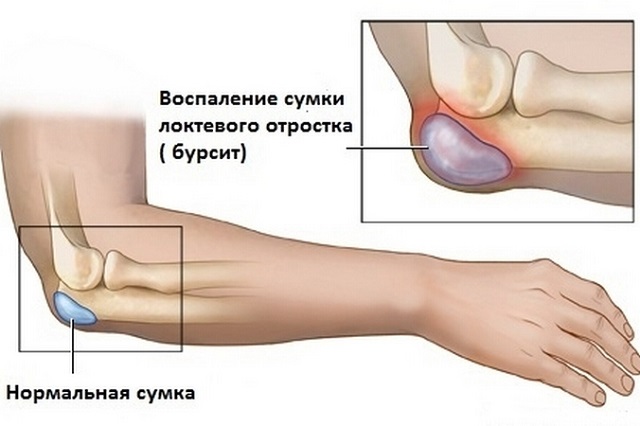 Elbow bursitis formation
Elbow bursitis formation Causes and signs
The main symptoms of the disease are:
- soreness in the elbow area;
- hyperemia;
- temperature increase;
- swelling;
- intoxication.
An abrasion or an ordinary bruise can cause bursitis in ulnar diarthrosis. Fluid accumulates in the bursa, the joint (diarthrosis) hurts and swells, the skin around this area turns red. Hand movement is difficult, and in some cases impossible.
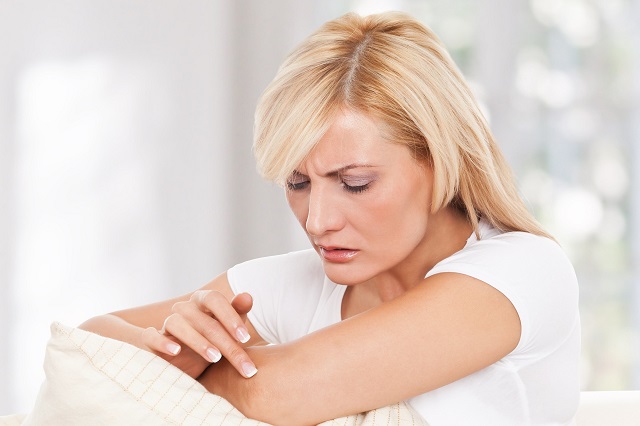 One of the main reasons for the development of bursitis is a contusion of the joint.
One of the main reasons for the development of bursitis is a contusion of the joint. First aid
At the beginning of development, bursitis of the elbow joint does not require special therapeutic measures. First of all, diarthrosis must be immobilized. To do this, you need to apply a tight bandage to the affected area. Complete rest should be observed for 5-7 days. This will prevent further injury to the bursa. At the end of this time, the doctor can remove the bandage and give small loads on the joint - gently bend and unbend the affected limb 2 times daily.
Elbow bursitis is treated on an outpatient basis. But there are many recipes for home therapy for ailments. Before using any of them, you should consult your doctor. He will determine the provoking factor, symptoms, analyze the course of the disease. Elbow bursitis can be treated with non-steroidal anti-inflammatory drugs, and in the case of an infection, with intramuscular antibiotics. In advanced cases, corticosteroids are prescribed.
A specialist will tell you how to treat ulnar bursitis at home and not on an outpatient basis. It is best to carry out all therapeutic measures under the supervision of a doctor. This will speed up recovery and eliminate the likelihood of complications. The surgeon deals with the treatment of the disease.
Medication treatment
During an exacerbation and in a chronic course, the doctor prescribes medications to relieve the inflammation of diarthrosis and antibiotics to reduce pain and prevent the aggravation of the pathology. Treatment at home should be agreed periodically with a doctor.
 Fastum gel, as a remedy in the fight against bursitis
Fastum gel, as a remedy in the fight against bursitis - Anti-inflammatory drugs - "Ibuprofen", "Voltaren", "Diclofenac". Used for oral administration. Available in tablet form.
- Anti-inflammatories and anesthetics. Available in the form of an ointment or gel. The most common are Fastum Gel, Diclofenac, Finalgon. The funds are applied 1 to 2 times in 24 hours to the area affected by inflammation, rubbing in a circular motion.
- Antibiotics Prescribing drugs depends on the sensitivity of pathogenic bacteria to the main components. Treatment of bursitis is carried out with antibiotics of a wide profile, which belong to the group of macrolides, penicillins or cephalosporins. The most common means are Fromilid, Cefazolin, Ampicillin. Antibiotics are prescribed in different forms - tablets and injections.
- Injection corticosteroids. They effectively eliminate inflammation, are injected into the bursa itself, relieve swelling and relieve pain. The course of therapy and dosage are individual, determined by the doctor for each patient.
Traditional methods
We bring to your attention recipes based on effective medicinal herbs and alternative medicine preparations:

 During rehabilitation, physical therapy is required.
During rehabilitation, physical therapy is required. Rehabilitation
Treating elbow bursitis at home takes several weeks. This period may be accompanied by discomfort and pain due to the active formation of scar tissue in diarthrosis.
When the course of therapy is over, the patient is prescribed a course of rehabilitation. It is necessary to restore the mobility of diarthrosis, tendons and muscles. The rehabilitation course includes simple exercises, gradually increasing the load, as well as massage.
With timely therapy and after successful rehabilitation, the bursitis of the elbow joint goes away completely. Relapses in the future do not bother the patient.
A disease such as bursitis of the elbow joint can be treated at home. But, folk remedies should always be combined with classical methods prescribed by the attending physician.
Elbow bursitis is an inflammatory process in the bursa. It contains liquid, its volume can increase or change its composition, leading to bursitis. Joint fluid is essential for adequate joint function to prevent deformation of the rubbing surfaces.
The composition of the fluid from the bursa can be different: purulent, hemorrhagic, serous, fibrous. Hemorrhagic contains blood, purulent contains big number leukocytes, bacteria, fibrinous contains fibrin threads, serous - the least dangerous.
Bursitis is divided into acute, subacute, chronic.
Often arthritis, gouty, rheumatoid or psoriatic arthritis precedes the development of the disease.
Occupational injury can lead to ulnar bursitis. This type of injury includes prolonged or frequent pressure on the most prominent part of the elbow.
Elbow bursitis affects different categories of people, regardless of gender and age.
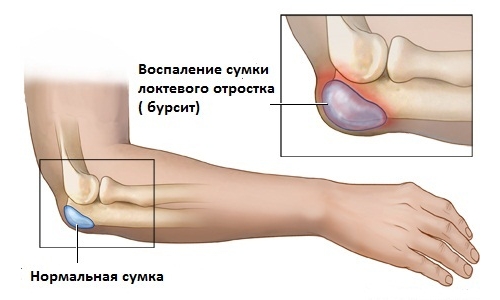
Ulnar bursitis symptoms
The first signs of bursitis are elbow swelling and pain. Joint mobility is limited. In some cases, the pain is mild. Sometimes a red, swollen ring forms around the protruding part of the elbow.
The difficulty in treating bursitis lies in the fact that many patients turn to a specialist only when severe pain in the joint. It is important to timely identify the disease and prevent its development. After the diagnosis is made, the doctor will prescribe treatment. Most often, a puncture of the joint with the extraction of accumulated fluid is recommended.
In modern medicine, instead of a full section of the joint, a special rubber tube with a balloon at the end is used to remove exudate. The balloon fills the cavity. The contents are removed using an aspiration needle. After the operation, several stitches are applied and physiotherapy is prescribed.
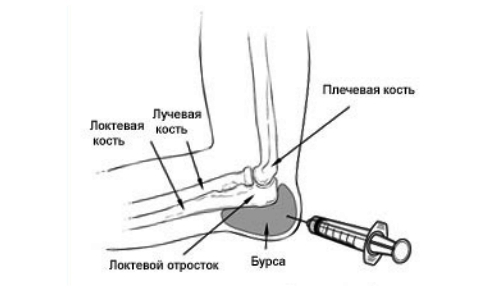
If you decide at home, notify your doctor. Only a specialist will tell you how traditional medicine is combined with traditional methods. Elbow bursitis not cured in time can lead to serious consequences, up to and including loss of joint mobility.
At home, bursitis is treated with compresses and herbal decoctions.
Effective compresses
The simplest compress is potato. To do this, you need to take a few raw potatoes, peel them, cut them into thin slices and attach them to your sore elbow. Secure the compress with gauze and a bandage and leave overnight. Do this carefully, avoid bandaging too tight. The procedure should be repeated within a month or until recovery.
![]()
There are more difficult way treating bursitis at home. To prepare it, you need a golden mustache - a plant from South America that adorns window sills in Russia. Golden mustache is very effective in treating more than just bursitis. Decoctions, compresses, tinctures from this plant will help fight a variety of diseases. People call it “homemade ginseng”.
Take 5 g of crushed golden mustache mustache, pour the resulting powder with 250 ml of boiling water, let it boil a little, and then leave for 1 hour. After the time has passed, when the broth cools down a little, strain it. Now you can dip a napkin in warm liquid and apply a compress on the sore elbow. A moisture-proof layer should be put on top of the napkin, and then a warm cap. A woolen scarf or other warming fabric can be used as a warm cap. The procedure is recommended to be repeated for three weeks.
An excellent folk remedy for treating ulnar bursitis is flax seed. For the entire course, you will need about 100 g of seeds. They should be warmed up, wrapped in gauze and applied to the sore joint. The compress should be kept until it cools down, and the procedure should be repeated for two weeks.

A similar effect occurs when using marine or table salt instead of flax seeds.
Treatment for elbow bursitis involves immobilizing the elbow joint. Prolonged immobilization should be avoided. Physiotherapy, such as electrophoresis, magnetotherapy, etc., promotes the rapid restoration of joint functions. After 12-14 days, you can try to make movements in the joint, although the sensations may be unpleasant.
As anesthesia, it is advised to apply Kalanchoe, but not freshly plucked, but frozen. Before freezing, the sheets are cut lengthwise to make drops of juice appear. Then it is placed in a freezer and, already frozen, through gauze, is applied in a cut place to the sore elbow. Remember that you should not apply frozen sheets directly to the skin, as this can cause frostbite. The maximum duration of the course of treatment with a Kalanchoe compress is 7 days.
Burdock root is a well-known folk remedy in the fight against various inflammations. The plant helps with skin diseases, baldness, acts as a diuretic, diaphoretic and choleretic agent.
To make a burdock compress, you need 10 g of dry crushed root. You can get it at the pharmacy or you can dig it yourself. Two-year-old burdock root is best suited for the treatment of bursitis; it can be harvested in May and April. The root of a young plant is useful if dug in September or October.
Pour 500 ml of boiling water over the dry root and leave for 20 minutes. Then moisten the cheesecloth in the infusion and apply it to your elbow. This remedy is irreplaceable if there is a threat of becoming chronic. It is advised to do the procedure for three weeks. The infusion of burdock root is not stored. If you feel sorry for pouring out, use it to rinse your hair.
Another folk remedy for the treatment of bursitis is very ancient and effective, but it has a characteristic pungent odor. To make a compress, you will need chestnuts, aloe, bile and vodka. Bile is purchased from a pharmacy. Three chestnuts and three leaves of grated aloe, crushed into flour, interfere with it. 500 ml of vodka is added to the resulting mixture and infused for 10 days. Store the tincture in a dark glass bottle in a cool place. Compresses from it are applied to the sore elbow for 1.5 weeks. Be careful when using bile, it has a pronounced specific odor.
Oral recipes
In case of joint disease, grapefruit juice is very useful. It should be drunk 100 g three times a day. It is not advisable to take grapefruit juice on an empty stomach - it can irritate the gastrointestinal tract. The consumption of freshly squeezed juices in general should be limited.
Treat bursitis at home using honey and apple cider vinegar. Into the glass warm water add a few drops of apple cider vinegar and a teaspoon of honey. You should take this drink up to two glasses a day after meals for a week.
Propolis with butter is perfect for treating bursitis. To do this, you need 15 g of propolis and half a packet of butter. Everything must be thoroughly grinded and taken before meals, 1 teaspoon for 10 days. The remedy is unsafe with a high content of cholesterol in the body.
Elbow bursitis can also be helped by a prayer to the mother of God for health.

 The periarticular synovial bursa is called bursa in medicine. It is located in those places where there is the most frequent friction between muscle and bone. Therefore, the inflammation of this periarticular bag is called bursitis. The most common disease is bursitis of the elbow joint, for which immediate treatment is necessary.
The periarticular synovial bursa is called bursa in medicine. It is located in those places where there is the most frequent friction between muscle and bone. Therefore, the inflammation of this periarticular bag is called bursitis. The most common disease is bursitis of the elbow joint, for which immediate treatment is necessary.
In general, the disease does not pose any threat to the life or health of the patient, however, it is accompanied by severe pain manifestations and significantly complicates movement in the joint. The most common occurrence is precisely traumatic bursitis, and it is mostly men who suffer from it.
Such a disease must be taken seriously, since in the case of frequent injuries, already chronic bursitis develops.
 This disease occurs due to:
This disease occurs due to:
- Overload joints... Here it is necessary to understand stretching or physical strain;
- Injury nearby tendons or periarticular bags. These include bruises, abrasions, minor wounds;
- Gout or arthritis... They also provoke inflammation in the tendons and joints with possible spread to bursa;
- Infectious factor... Secondary infection of the synovial bag through the lymphatic tract with pyogenic microbes or through the blood.
The provocateur of this disease is often a metabolic disorder, autoimmune diseases, allergic reactions, and intoxication. In frequent cases, the disease can occur even in the absence of visible reasons for this.
Symptoms and types
 The main symptom of bursitis is a periarticular tumor, accompanied, in addition to painful sensations, by impaired functioning of the limb. The location of the disease is superficially determined visually and independently, based on the detection of a well-mobile, as well as hot to the touch, tumor. Distinguish between acute bursitis of the elbow joint and bursitis chronic or recurrent.
The main symptom of bursitis is a periarticular tumor, accompanied, in addition to painful sensations, by impaired functioning of the limb. The location of the disease is superficially determined visually and independently, based on the detection of a well-mobile, as well as hot to the touch, tumor. Distinguish between acute bursitis of the elbow joint and bursitis chronic or recurrent.
Let's look at acute elbow bursitis. The disease begins with severe pain, which only intensifies during movement. A very painful point will always be present above the inflamed joint, and the pain itself can radiate to the neck or spread down the arm. At the site of inflammation, there is not only severe swelling, but also redness. In particular, the diameter of the edema can be from 8 to 10 cm. Due to the course of the inflammatory process, an increased body temperature is always recorded in the range of 37 or 37.5 degrees.
If chronic bursitis of the elbow joint is diagnosed, then the pain sensations in this case are much weaker, but the time of its course is quite long.
The disease manifests itself in the form of a dense formation with mobile skin at the point of the focus. The functionality of the limb is not impaired. The disease in this form is accompanied, in most cases, by calcium deposits.
Treatment of the disease
Treatment of elbow bursitis pursues, first of all, complete elimination and elimination pain, as well as the inflammatory process. Remember, at home, it is impossible to treat and cure this disease. This cannot be done even when you use proven folk remedies. We do not claim that they are ineffective, however, treatment should only take place under the supervision of an experienced physician.
Depending on the form of the disease, the doctor will prescribe the appropriate treatment. At the initial stage, it will be necessary to provide the diseased joint with absolute rest. For this purpose, a tight fixing bandage is applied to it, and a decrease in the intensity of inflammation of the elbow joint is achieved by applying warming compresses to the area of the synovial bag.
However, these steps do not end the treatment. Methods are used such as:
- drug treatment;
- physiotherapy;
- surgical intervention.
Drug treatment
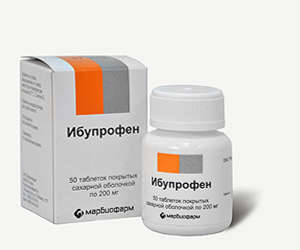 In the case of an acute or chronic course of the disease, anti-inflammatory drugs are prescribed, such as Diclofenac, Ibuprofen, Voltaren. In parallel, treatment with antibacterial drugs or antibiotics is carried out. In this case, those drugs are prescribed to which pathogens are sensitive.
In the case of an acute or chronic course of the disease, anti-inflammatory drugs are prescribed, such as Diclofenac, Ibuprofen, Voltaren. In parallel, treatment with antibacterial drugs or antibiotics is carried out. In this case, those drugs are prescribed to which pathogens are sensitive.
If the disease is mild, then in most cases the treatment of the elbow joint will be limited to the use of a variety of gels.
Special ointments are also used. Such therapy is very often prescribed as an adjunct. Especially intensively used are ointments with an excellent warming effect.
Physiotherapy
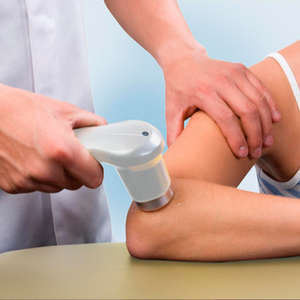 Despite the type of disease, edema and pain syndromes are relieved by using physiotherapy. This uses heat, cold, ultrasound and UHF.
Despite the type of disease, edema and pain syndromes are relieved by using physiotherapy. This uses heat, cold, ultrasound and UHF.
In order to prevent illness in any of its forms, doctors recommend at home, immediately after injuring the elbow, to apply cold to it. In the event of the development of the disease, it is necessary to use the thermal effect on the affected area.
Surgical intervention
They resort to it only in the case of purulent inflammation of the synovial bag or in the chronic form of the disease.
There are three forms of surgery - drainage, bursal puncture and bursectomy.
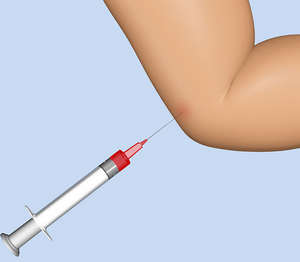 It consists in removing purulent contents from the inflamed cavity, followed by rinsing with special solutions. It is also possible to administer antibacterial agents and / or corticosteroids with pronounced anti-inflammatory effects.
It consists in removing purulent contents from the inflamed cavity, followed by rinsing with special solutions. It is also possible to administer antibacterial agents and / or corticosteroids with pronounced anti-inflammatory effects.
Drainage
It is used in case of severe purulent inflammation. It consists in opening the cavity of the ulnar bursa, followed by the use of a drainage tube. It is left until the purulent discharge stops.
Bursectomy
It is a surgical excision of the synovial bag of the elbow joint and, as a rule, is used in the chronic form of the disease. It is performed under local or general anesthesia, followed by suture. After several days, a splint is applied in order to provide the joint with peace, as well as for faster healing of the surgical wound. During the rehabilitation period, a new synovial bag is formed from the connective tissue.
Treatment with folk remedies
 In relation to this disease, not only drug treatment is practiced. In some cases, bursitis can be cured with folk remedies, but only with the permission of the attending physician.
In relation to this disease, not only drug treatment is practiced. In some cases, bursitis can be cured with folk remedies, but only with the permission of the attending physician.
You can treat this disease using the following recipe: two tablespoons of honey and one aloe juice are mixed until a homogeneous mass is formed and applied to a gauze bandage, which, in turn, is applied to the inflamed area, after which it is wrapped in cellophane, and then with a bandage for the purpose fixation. This compress lasts for two hours.
In the case of a purulent form of the disease, it will have to be treated differently. In this case, you will need 1 tbsp. l. chopped household soap and grated onion. Everything is mixed, after which it is applied to gauze, which is applied to the damaged area and fixed with a wound woolen scarf or shawl.
In a mild form, the disease can be treated with folk remedies, but in most cases, the intervention of modern medicine is necessary.
7137
Bursitis is an inflammation process that develops in the bursa of the joint. To understand the process, it should be said that around each joint there are several synovial bags that are filled with liquid contents. They are intended for shock absorption (separation of one articular surface from another) and protection of joints from traumatic injury.
Most often, the knee suffers from injury, and the elbow joint is in second place in terms of the frequency of injury.... It contains three bags, each of which contains a certain amount of clear fluid (interosseous, ulnar subcutaneous and interosseous ulnar). The inflammatory process in one of these bags is called bursitis. Let us consider in more detail what are the causes of the disease, and how to treat bursitis of the elbow joint.
Varieties of bursitis
Bursitis, like any inflammatory disease, is acute, subacute or chronic. In addition, the specific type of bursitis depends on which of the bursae is damaged. The quality of the fluid contained in the bursa for a given disease is also taken into account. Therefore, bursitis is distinguished: 
- serous;
- hemorrhagic;
- purulent;
- fibrous;
- mixed.
If the disease is based on the introduction of coccal flora, then the process is considered nonspecific. And for violations associated with tuberculosis, gonorrhea or syphilis, we are talking about a specific bursitis.
Why does bursitis occur?
The cause of this pathology may be:- arthritis of any genesis;
- joint microtrauma;
- monotonous identical movements (occupational pathology);
- infectious infection with damage to the soft tissues of the hand, as well as the penetration of infection from distant foci by the lymphogenous or hematogenous route;
- endocrine pathologies (diabetes mellitus);
- decrease in the body's immune forces;
- long-term use of certain drugs;
- metabolic disorders;
- constant physical overload;
- autoimmune diseases.
In rare cases, inflammation occurs for no apparent reason, then it is called idiopathic bursitis. Some experts believe that in fact this type of inflammation occurs after an injury that has occurred so long ago that it is difficult to combine them with each other.
The main signs
With a disease such as bursitis of the elbow joint, the symptoms are different, and treatment is prescribed depending on the type and course of inflammation. Most often, the signs of the disease are as follows:
- Edema in the area of the inflamed bursa, it can be of varying degrees of severity. Sometimes the pathology is completely painless and does not even interfere with flexion and extension in the elbow joint.
- If left untreated, synovial edema may increase further and cause discomfort or soreness.
- With some types of bursitis, significant swelling begins, the skin in this area turns red.
- Often, bursitis is accompanied by fever and worsening of the general condition. The patient complains of headache and muscle pain, sweating, decreased appetite, worsening mood.
- As the swelling increases, the mobility of the elbow joint decreases.
Depending on the form of the disease, symptoms can manifest themselves in different ways:
- With acute serous inflammation in the area of damage, edema is palpable, the bag increases in size, minor painful sensations and some local increase in temperature occur.
- If you do not treat bursitis of the elbow joint, then with a slight damage, an independent cure is possible, or a transition to a chronic process. In this case, the symptoms are expressed exclusively during the period of exacerbation, but with a long course of such a pathology as chronic bursitis of the elbow joint, seals can be felt in the affected area. And the longer the process lasts, the more pronounced the seals. At the slightest influence of provoking factors, a relapse is noted.
- The addition of an infection often leads to the development of purulent bursitis of the elbow joint. In this case, the pain becomes severe, sometimes even unbearable, and the joint area becomes hot and red. A change in the general condition is noted.
If bursitis of the elbow arises, only a specialist knows how to treat it. Therefore, you do not need to use untested methods, and try to improve the condition on your own. Such actions can cause irreparable harm to yourself.
How is elbow bursitis relieved?
Treatment methods for bursitis depend on the cause of its occurrence and the type of inflammation. First aid in the absence of a purulent process consists in applying a pressure bandage in order to reduce the severity of edema. To ensure minimal physical activity, it is advisable to use a special kerchief that supports the limb in a certain position.
Medication assistance
To help with bursitis, the following types of drugs are used:
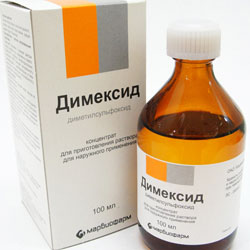
How to treat elbow bursitis if conservative therapy does not help? For this it is used surgery... And if earlier the traditional method involved the complete removal of the bag, and this led to the fact that the patient spent a long time on recovery and not always successfully, then on this moment there is a more gentle technique. It consists in removing the entire contents of the bursa using the puncture method, preserving its shell.
Using folk methods
With bursitis, treatment with folk remedies must be carried out in combination with traditional methods of therapy. But only on condition that they are approved by the attending physician, since he knows well how to treat ulnar bursitis in a particular case in a given patient.
- The easiest and most affordable way is a saline compress. For it, you just need to dissolve a large spoonful of ordinary salt in water (0.5 liters), moisten a natural cloth, put it on a sore spot, put a film on top and wrap it with a warm scarf. The duration of the procedure is about eight hours. It is best to spend it at night, for one week. This treatment draws excess fluid from the inflamed bursa.
- A very famous remedy that can cure bursitis is the cabbage leaf. It is first beaten off, then the elbow is greased with honey and covered with a sheet on top. Then - with a film and a warm cloth. This not only leads to the removal of edema, but also relieves inflammation..
- It is very useful for joint diseases and bursitis to use medicinal baths. The most useful of these is coniferous, which can be prepared from pine needles and cones. They need to fill a large bucket, pour boiling water and insist for six hours. The product should be used for the bath after straining. Take within 20-30 minutes at a temperature of about 38-40 degrees.
- What else can you treat a sore joint? Traditional healers recommend using ointment with honey. For her, two parts of honey are taken into three parts of alcohol and one part of aloe juice.
- Elbow bursitis treatment folk ways involves the use of honey with onions and laundry soap. For a pound of honey, one medium onion and a regular bar of soap are taken. All ingredients are thoroughly mixed and used as a compress. You need to do it before bedtime, only three weeks.
- If there is such a sign of bursitis as edema, then a chestnut-based balm will help. For the manufacture of two glasses of crushed chestnuts, one bottle of pharmacy bile is taken, and then several sheets of aloe are added there. After all the components are thoroughly mixed, you need to add 500 ml of medical alcohol to them. The balm is considered ready if it is infused for ten days in a dark place. It is used as a compress and aged overnight. The treatment course is 10 to 15 days.
